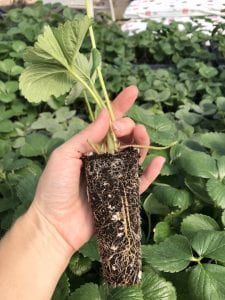
This protocol describes steps to transform standard dormant bare-root strawberry crowns into actively-growing plug plants.
Why use plugs instead of crowns?
Strawberry plug plants can handle transplanting during hot summer months with less stress than dormant crowns. Dormant plants can only tolerate cold storage for so long. This procedure gets the plants growing before they expire in the cooler.
Starting dormant crowns early in the greenhouse will give an advantage in growth through the growing season, including extending the fruiting season of everbearing varieties.
Finally, plug plants can be established with a water-wheel planter, significantly reducing hand labor and increasing transplanting speed. Nurseries that grow plug plants often have limited varieties available and finishing dates that are too late for northern growers.
Do not confuse this protocol with creating plugs from runner tips, which requires a propagation license for patented varieties.
Materials:
- Dormant bare-root strawberry plants (crowns); any variety can be used
- 2” x 50-well plug trays (5.1 x 5.1 x 7.0 cm)
- Soil-less ‘potting’ mix
- Irrigation equipment (manual or sprinklers)
Timing:
Plants will take approximately 6 weeks to establish root systems in the trays. Plan to start these plugs 6-7 weeks before anticipated field planting date.
Process:
- Trim roots of crowns to 5 cm (2 in) (discard weak or moldy plants).
- A good pair of scissors works better than pruning clippers
- Place trimmed crowns in empty holes of a plug tray.
- Fill over the tops with moistened (not wet) soil-less mix.
- Water over the top to settle soil-less mix, add more mix if needed.
- Place plants in open cold frame or on greenhouse bench.
- Irrigate with overhead water daily, or more often, if media becomes overly dry.
- Fertilize with complete blend (20-20-20 or similar) weekly.
- Remove any flower buds that emerge.
- One week prior to planting, move plants outside to harden up (if not outside already).
- Plant into field or production containers.
Prepared by:
- Esther Kibbe, Western N.Y. Berry Specialist, Cornell Cooperative Extension
- Courtney Weber, Horticulture Section, School of Integrative Plant Science, Cornell AgriTech
